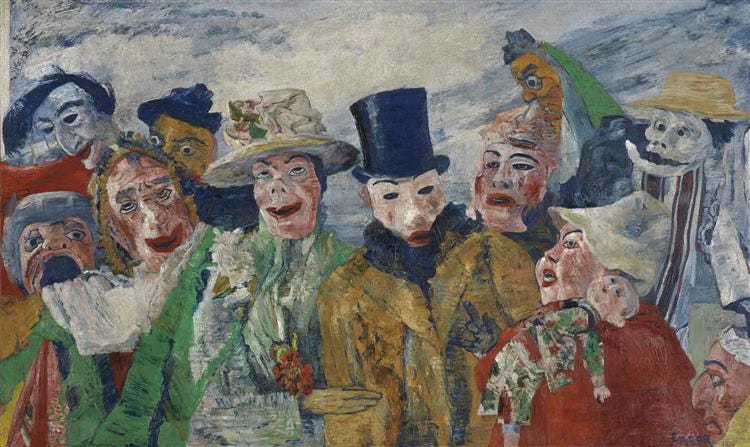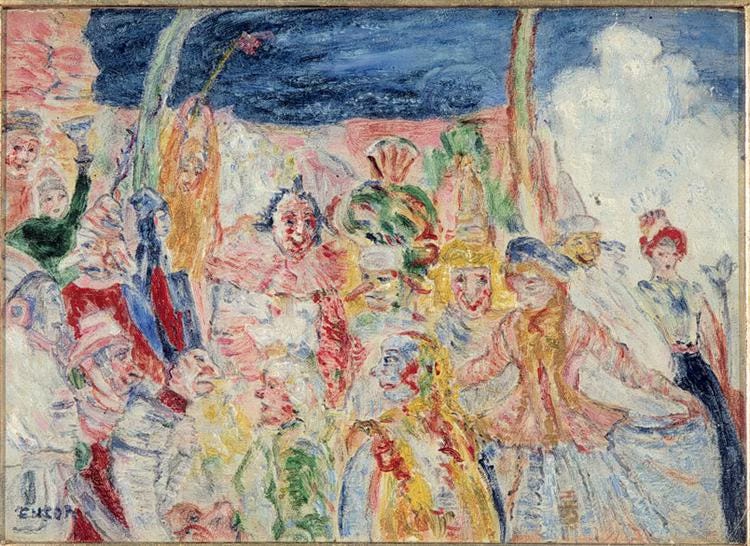Happy, Hopeful, Holy
A Different Kind of Halloween
Until recently, I never really appreciated Halloween. In both its origins and contemporary practice, it is a rather dark holiday. Historically, folks carved jack-o-lanterns to ward off evil spirits and dressed up in costumes to disguise themselves from vengeful ghosts. Some believed that on the night before All Saints’ Day (All Hallows’ Eve), the dead rose from their graves to participate in a wild dance accompanied by Death himself. Though few today would espouse these beliefs, Halloween still offers an occasion to flirt with fear and mingle with the macabre. A walk around my neighborhood in late October reveals ghosts, skeletons, werewolves, hanging bodies, and severed heads. And we tend to think of it as a children’s holiday!
Perhaps my modern cosmology is too sterile to accommodate Halloween, or perhaps I am just a scaredy-cat, but every October 31st, I would find myself facing a strange annual ritual that offered little significance or enjoyment. Granted, it provided an occasion to gather with friends, eat autumnal treats, and nurture our children’s imagination, but I could think of many ways to do that without all the accoutrements of darkness. “Give me a good harvest festival instead of Halloween!” I would say. “Why must we add demons to our fall festivities?”
My perspective has changed since I began taking my children trick-or-treating. An activity that for me felt mostly mundane and awkward was, for them, a real adventure. They stepped into the twilight with all the excitement and trepidation of a treasure hunter seeking booby-trapped riches. The evening was, after all, filled with deliberately frightening images. At several particularly spooky entryways, they refused to approach the door; the possibility that the werewolf on the bench might actually be alive had become too likely in their minds. With some encouragement and sometimes an accompanying adult, they stepped forward and found that their fears far exaggerated the reality: The werewolf was fake, and the owner of the seemingly haunted house was no witch. Again and again, what my kids discover on Halloween is that behind the frightful facade is a kind neighbor, and behind the mask is not a monster, but another child.
That revelation would not land with such force, if at all, without the darkness of Halloween. In this light, trick-or-treating now seems to me like a kind of exposure therapy. With the help of Halloween decorations, we imagine the worst possible scenario—say demons rampaging next door—and then, rather than assuming it is true or running away from it, we force ourselves to approach it, and inevitably discover that our fears far exaggerated the reality. We might still find an awkward neighbor or receive a Halloween humbug, but compared with the demonic alternative, these now seem minor lapses in social grace, not fatal flaws. At Halloween we are ritualistically reminded that much of what might seem true of each other is, upon closer inspection, false. Children learn that their neighbors will give them candy upon the asking (!), and adults realize that most members of the community, if given the opportunity, will be kind and generous, and are willing to create space for children.
As this realization originally dawned on me, I teared up as I watched my neighbors, sometimes emerging from doors bedecked with blood, interact warmly with my wide-eyed children. Door after door, I saw my neighborhood enact a moment of redemptive revelation. At one point, I tried to explain the miracle I was witnessing to another parent, but I couldn’t quite manage the words. So I stood in the street and basked alone in my neighbors’ goodness, revealed to me most unexpectedly on Halloween night. It was a pearl all the more striking for the dark velvet on which it was displayed.
As I remember that moment, I wonder why I found it all so moving. Perhaps it was because, in this age of epidemic loneliness, cultural distrust, and partisan hostility, my soul longed for community, redemption, and love. Perhaps it was because I felt the darkness not only around me, but within me. Though most of us today do not believe in evil spirits, vengeful ghosts, or the dance of the dead, we are still haunted by the dark. Halloween makes visible the shadows we live with, makes tangible the fears that loom. It is a dark holiday for people who walk in darkness and live under the shadow of death, however they are understood and imagined.
Halloween acknowledges the darkness around and within us and gives it a figurative face. And then, it invites us to respond in a radically unexpected way: to approach the threshold of another and knock—to take the position of a beggar, placing ourselves momentarily at another’s mercy. And for those who hand out the treats, Halloween asks us to respond generously to the knock of the Other—to look beyond the masks, however horrifying they may appear, and offer hospitality.
To knock is to risk rejection; to open is to risk intrusion. Both entail some danger because there is real darkness in the world. Political policies and rhetoric do have real consequences, sometimes for the worse. Movements rise and fall that can distort truth and corrode virtue. There are bad actors with nefarious designs. But Halloween reminds us that our perception of darkness does not always reflect reality: The house we fear may conceal kindness; the mask we dread may hide a face not unlike our own. Crossing the frightening front porch is risky, but, as my children learn, it is often rewarding.
The subtle sermon beneath the bustle of the holiday is that, while darkness exists, so does light; that neighborliness, generosity, and goodwill can be found even in the darkest of nights; that our common humanity is more fundamental than the masks we wear. And, perhaps this: That ultimately, the way out of the darkness lies at the threshold—in our willingness to knock on another’s door and to open ours.
These days, I find Halloween profoundly hopeful. Maybe even holy.
David Sabey is a husband, father, educator, essayist, and amateur pizzaiolo. He’s trying to get better in each of those domains.
Art by James Ensor (1860–1949)





